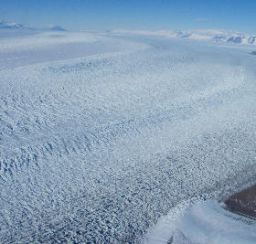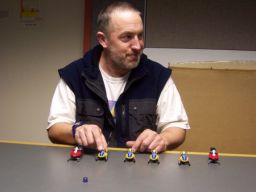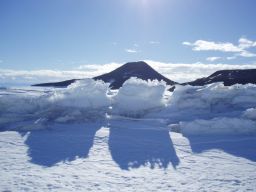ANSMET team • Dec 22, 2008
The Antarctic search for meteorites: more waiting; runway's ready; ralph goes home
December 17-22, 2008
Paving the Way
December 17, 2008
If there are no technical hiccups, this will be the first post from the deep field.
Although ANSMET has been working in Antarctica every year but one since 1976, every year has the potential to bring new surprises. This year was no exception. For the first time, ANSMET is preparing its own snow skiway for the airplane that will bring the team into the field. The reason for this is complicated, but in essence, it was caused by problems with airplane scheduling in Antarctica. ANSMET offered a solution: We would prepare a deep field skiway for the Basler airplane to bring the main team out into the field.
The Basler is a plane built on the frame of the old DC-3 of legend. Basler pilots do not want to land on very rough surfaces. In Antarctica in the deep field, rough surfaces are the norm. The strong winds here sculpt snow into hard drifts called Sastrugi. Sastrugi are so hard you can drive a snowmobile over them with hardly a dent being made. (Quite the contrary, if you drive a snowmobile over sastrugi too fast, you can break the suspension!) So something had to be done to prepare our target site for the ANSMET team.
John Schutt and I were flown out on 11 Dec. with equipment to prepare a snow skiway. Neither of us had done this before, but the task seemed simple enough. We would drive up and down on a snowmobile dragging a heavy steel grooming device. It would chew up the hard-pack snow with four “teeth” and spread it out with a rake. Things were going smoothly (note clever pun) up until a joint on the groomer broke. This was on 12 Dec. This brought work to a screeching halt.
The solution is to get a replacement groomer flown out to us on a Twin Otter. This seems simple enough. Just tell that to mother nature. After we put in our call for the replacement, bad weather set in at McMurdo and then South Pole. All Twin Otter flights were cancelled. For days.
John and I are used to this waiting game. We haven’t been totally idle. We have gone out and foot-searched areas near camp for meteorites, and have found around twenty. We left them where they are, but marked them so we can find them easily when the rest of the team arrives. The rest of the team will bring the special collecting gear we use to harvest meteorites off the ice without contaminating them.
The wait ended today. A Twin Otter arrived in the evening with the new groomer and some other gear. We rapidly put the groomer together and are back at it paving the skiway.
I call it Schutt Field.
In 1907, Ernest Shackleton (later Sir Ernest) was leading a team of explorers to attempt to be the first to reach the South Pole. One hundred and one years ago on this date, his team was ascending the Beardmore glacier on foot, pulling sledges laden with hundreds of kilograms of gear. They were about 70 kilometers (45 miles) north of where the ANSMET camp is located.
If you would like to learn more about Sir Shackleton’s heroic journey, John and I recommend getting a copy of “The Heart of the Antarctic” by Sir Ernest Shackleton. This book is Shackleton’s account of his attempt to be the first to reach the South Pole.
Cheers,
duck
North for the winter
December 18, 2008
This little birdy is flying North later today. Since March I had planned to spend only a short time in the field this season- about 10-12 days (in fact I wasn't sure I'd go to Antarctica at all because of family obligations whose schedule I couldn't control). Knowing this, I made sure the 08-09 field team was flush with veterans who could keep things going in my absence. And although I have been here right up to the moment of field team deployment, the delays that have built up (about 8-9 days) now make it silly for me to go into the field, for a couple of reasons. First off, my exit from the field (and Joe's entrance) was meant primarily as a resupply mission; an opportunity to get a little more fuel, or stuff we have broken or lost 10-12 days into the season. It makes little sense to have a resupply two days after we get into the field, particularly since we will have had 5 flights over the past week. Second, going out into the field simply to observe for a day or two is a huge waste of resources during a field season where air logistics are so strained that many projects are simply wrapping up and going home. For me to waste a flight under those circumstances, when we're one of the LUCKY groups actually getting to do our field work, would be a slap in the face of many. I can't do that. Finally, simply staying in the field longer isn't an option for me this year (see family obligations clause above).
So with 95% of my job as Principal Investigator of ANSMET done (getting the field season underway), and my replacement ready to go, I'm going to gracefully step out of the way. The field season goes on, just without me. I won't deny that this feels very, very wrong on a personal level; I really do live to hunt meteorites, and the thrill I get being out on the plateau and finding rocks that have been untouched since the birth of the solar system hasn't diminished at all. But it's the right decision in every logical way. The hardest part of my job really is done; the field team will end up with a better schedule of resupply missions, and we can honestly say that our project made sacrifices to avoid wasting any logistics. And of course I get one personal perk out of this; if the flight schedule allows I should be home for Christmas with my family for only the 2nd time in the last 10 years.
And if any of you have exceptional psychic abilities, please send emanations to Qantas/American Airlines that will open up a few seats on those chc-akl, akl-lax and lax-cle flights I'm trying to get on! Dec. 19 would be nice.
-Ralph
Call me…Plow King
December 18, 2008
Today we got right at it. As soon as breakfast was done, John went out and started grooming the skiway. After he got tired, I took over. So it went all day until supper. We each put in several hours on the snowmobile during the day, and we made great progress. I am sure the Basler pilots will compliment us on such a fine, fine skiway.
We were aided by good weather. The wind speed is relatively low today, and this helps us stay outside for long periods without suffering from the cold. Indeed, I could have stayed out all day without trouble. John thinks we only have about an hour’s worth of work left to do. We will be ready for a Basler landing tomorrow. Hopefully, a flight can be arranged and the rest of the team can begin to arrive.
In a previous post I mentioned that John and I had done some foot-searching while we were waiting for the replacement groomer. When I was not busy plowing, I went out and imaged a couple of the rocks we found. One is the first meteorite discovered by the 2008-2009 ANSMET team. It will not get an official meteorite name for several months; not until a preliminary examination is done by scientists at NASA Johnson Space Center and the Smithsonian Institution. For the time being, I’ll call it “Alphonse.”
Alphonse is typical of the meteorites we find. Many are about this size, they are rounded, and often have a black glassy coating known as fusion crust. Fusion crust develops on meteorites as they pass through the atmosphere. Friction with the air molecules heats up the outer surface, melting it, and smoothing any sharp points the rock may have had in space. When the meteorite slows down, the melted coating freezes to a black glass, the fusion crust.
Sometimes we find rocks that we are not sure what they may be. We have found one already. I will call this rock “Curly” after my favorite of the Three Stooges. This is a black shiny rock. It is not like any other Earth rock we have yet seen in the area, but it is also not like any meteorite John or I remember seeing. We have marked it, and will wait for further information before we decide whether to collect it or not.
One thing Curly could be is coal. There are coal seams in the Transantarctic mountains. In fact, just north of here in the Queen Alexandra Range there is coal. I was there with ANSMET in 1997-1998. My memory is that the coal does not look exactly like Curly, but that was 11 years ago, and I an not sure. After looking at Curly again today, I am beginning to think that it is coal.
While we are searching this year, we will keep our eyes open for other rocks like Curly. If we decide Curly is definitely coal (or some other Earth rock), we will leave it where it is. If at the end of the season we still cannot decide, we will collect Curly. ANSMET prefers to collect a few atypical Earth rocks rather than take the chance of leaving a new and unusual meteorite behind.
101 years ago on this date: After traversing the Ross ice shelf and the Beardmore glacier, Shackleton’s expedition finally reached the Polar Plateau. They man-hauled their sledges of gear and food up the slope, crossing difficult pressure ridges and dangerous crevasses. They covered six and a third miles, but because they could only take half their gear at a time, they actually walked nineteen miles, climbing the slope up to the plateau pulling heavy sledges twice!
Cheers,
LYAN
duck
Esperemos
December 19, 2008
Two full weeks have gone by since our arrival in McMurdo, and we inch ever closer to getting into the field. The key word in that phrase is inch. Since NSF has discouraged overuse of the LC-130s due to fuel costs, the Ken Borek Twin Otters and Baslers are oversubscribed. Our field site is far enough away that we really need the Basler, which is larger than the Twin Otters by maybe double, for our three put-in loads of gear and passengers. But other groups need these planes as well, so the pilots continue to put in long hours, and we continue to wait. We're currently hopeful for a Monday (eek) put-in.
We each pass the time in our own special ways. We all meet for meals (although breakfast has started to slip now that Ralph has gone home...) and usually finish the evening together at the coffee house or another establishment. Last night we were at Scott Base again for American night. This is a short, lovely jaunt up the hill and two miles over, and though we suspect Joe walked home last night for the nice views of Erebus, the ice shelf, and Ob Hill, the other three of us took the lazy, shuttle mode. From here the plans vary widely - Joe probably hits the sack first, followed by me, after an episode of Firefly or similar, while Deon and Amy either watch more DVDs or go to Crary to work on LPSC abstracts or the weblog until the wee hours. It's easy for this to happen, since there are no bedtime cues from the sun! I believe we'll become fully nocturnal by next week if we don't get into the field.
I took over Ralph's few remaining tasks in McMurdo to become transportation and cargo mistress - a title I relish and abuse. Basically this involves walking around to the different departments, checking on our flight status and location of our cargo still waiting to go into the field. I find I'm becoming more and more Ralph-ian all the time - I wander around town in my Carhartts, baseball cap, and pager talking with people, checking the flight schedule, and raiding the skua bins. It's scary. The flight ops girls have told me to just call from now on, don't come by.
Here's hoping they run us out of town before we can do any more damage.
A few side notes: We appreciate Emily Lakdawalla's coverage of our blog on her Planetary Society blog, we're glad she's helping to spread the word. So I guess I just blogged her blog of our blog? It's a blog war! I'm sure there's some geek-speak for that... Also, props to Barb, Nick, Dave, the Rads, and Troy for the mail - many thanks!
And finally, our sympathies go to the family of Steve Ostro. He was a strong proponent of research on small bodies in the solar system, so we feel he is an ANSMET kindred spirit. He'd have loved coming down with us.
-- Jani Radebaugh
The Waiting Game
December 22, 2008
We continue to wait in McMurdo to be deployed and as I write (knock on wood), our first gear flight will go in on Monday. In the meantime, we’ve been hanging around McMurdo fulfilling a role we’ve learned is termed a UE or “Useless Eater”. We’ve been enjoying the recent weather in McMurdo, which has been relatively warm and sunny. We just hope we don’t use up all the good weather karma before our put-in flights next week!
Yesterday I took advantage of an unexpected opening and went along for a tour of the pressure ridges near Scott Base. An arrangement has been worked out with the Kiwis to allow several tours a week from McMurdo. Our group lucked out with excellent weather and good lighting for pictures. The pressure ridges are due to buckling and cracking where the sea ice meets the permanent ice shelf. The result is amazing ice formations. The pictures don’t really do them justice. Many had a beautiful deep sky blue color and their edges had sometimes been sculpted into intricate patterns through the combined actions of wind, melting, and sublimation. There were also several light blue pools of melt water to be seen along the path. The pressure ridges were especially high this year, according to several trip members who’ve seen them develop over the past few years. Seals sometimes come up through the cracks in the ice associated with the pressure ridges, though our tour did not happen upon any. Jani, Deon and I did however catch a few lazing about near some cracks in the ice near Hut Point, on a different day’s jaunt around McMurdo.
Cheers,
Amy
Status Update
December 22, 2008
A quick update on our schedule...Our first cargo flight went out this morning (Monday). The weather looks good and another flight is scheduled in 2 hrs. If all holds, the remaining 4 of our team in McMurdo will put into the field early on Tuesday morning. Keep your fingers crossed for us, because we are REALLY ready to go collect meteorites!
Last night we were invited for dinner at Scott base and asked to give a science lecture. It went really well, and the Kiwi's were not only very interested by our work, but were also a very interactive audience and we all had a very enjoyable time. We were very jealous of the fireplace they have in their reading room!
Aloha,
Deon.
Support our core enterprises
Your support powers our mission to explore worlds, find life, and defend Earth. You make all the difference when you make a gift. Give today!
Donate

 Explore Worlds
Explore Worlds Find Life
Find Life Defend Earth
Defend Earth












